
| Time duration | 5 months |
| Location | Lahore and Mangla |
| Organization | Department of civil engineering, University of and technology, Lahore |
| Project | Failure Analysis of Sukian Dyke Landslide in Case Mangla Dam after 2014 Flood Season |
| Position | Lead Civil Engineer |
This career episode is related to my project titled “Failure Analysis of Sukian Dyke Landslide in Case Mangla Dam after 2014 Flood Season”. This project was carried out as part of my Bachelor of Science in Civil Engineering degree requirement from …12/1/2015…..to …10/06/2015…
[CE 1.1]
The project was carried out during the Bachelors Degree in Civil Engineering. I completed this project by teaming up with two other team members & it was completed under the supervision and direction of our project supervisor.
[CE 1.2]
During my course work studies, I have studied analysis of soil which wedged my attention and I decided to pursue a project on this subject. I was invigorated by my supervisor for undertaking this project as it addressed a practical problem & was an extraordinary project amongst many other choices. I was able to complete this project efficaciously within the deadline. I was able to take in to account all the relative common & uncommon issues accordingly. My competence as a project patron was even valued by the Project Supervisor.
[CE 1.3]
The length of Sukian dyke of Mangla dam is about 5.33 km .The core material used in Sukian dam is B type sandstone so Sukian dam is an earth fill type dam.. A- Type sandstone is applied on the shoulders. The peak height of embankment at intake above the core trench is 144 feet while the length is 16,900 feet. A complex active landslide that has progressed over the years has got worst due to the severe flood in 2014. WAPDA undertook repeated low cost measures to mitigate the damages due to flood. Currently, NESPAK has been contacted to redesign the dyke.
The landslide area is located near Mangla Dam. Dyke slope has a relief of 1230 m. The landslide initiated in 2014 and gradually developed to a multiple landslide complex. IRSA and WAPDA undertook series of measures to reinstate the landslide affected reach, but the situation got worst when the flood hit the affected area. The chronological order of development of the landslide and previous remedial measures undertaken by the department of WAPDA were carried out during the site visit for the collection of samples.
[CE 1.4]
The prime objectives of the project were
[CE 1.5]
This project was primarily envisioned by me & for guidance I referred to my project Supervisor,
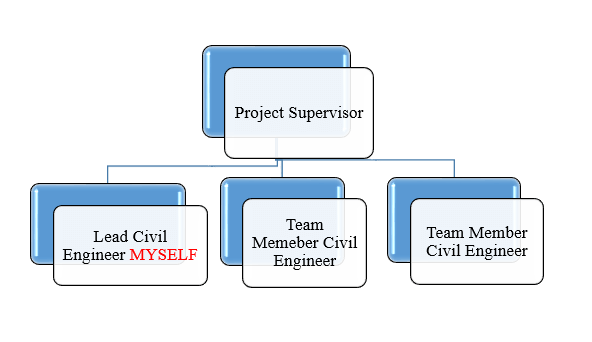
[CE 1.6]
The foremost objectives in the project were:
[CE 1.7]
I did all possible online & offline research to have broader view about the analysis if landslide. In addition to this during the project lifespan I had consistent meetings with my peers & project supervisor in order to debate about the snags & hitches. I also had the task to concoct documents & reports with diagrams for unfolding the entire process. Finally, Project report was offered for review of project in which all-inclusive process was described.
[CE 1.8]
My roles & responsibilities were -
[CE 1.9]
I conducted a detailed site reconnaissance visit in order to understand the landslide mass movement phenomenon and to frame the work methodology for the study and analysis of stability. I studied the information about the historical background of the landslide. I held a detailed meeting with the local management authority & topographic section data of the landslide along with sub surface geological data information were collected which were of vital information for the analysis of the landslide. From all the information collected during the site visit, ‘SUKIAN DYKE’ landslide can be classified as flood induced landslide. I noticed wide open cracks at the top of the hill slope.
[CE 1.10]
I collected sufficient quantity of bulk samples from the slide material to find out the residual shear strength characteristics and in-situ shear strength parameters of the soil mass were collected.
I took undisturbed block samples from the failure surface to investigate the in- situ condition of the soil.
I collected sufficient quantity of bulk soil samples from different locations of the slide mass. I packed these samples in two bags and in a container & brought to geotechnical lab. I performed multiple tests on the bulk sample in order to deduce the required results.
[CE 1.11]
I brought the soil samples collected from the site to laboratory in order to perform the laboratory tests for evaluation of desired soil properties to be used in the analysis.
I prepared a laboratory testing program which included the following tests:
[CE 1.12]
I carried out this analysis on bulk samples collected from the site following the SOP listed in ASTM D422-63 Standard Test Method for Particle Size Analysis Soils. The gist of the test was to examine the particle size dispersal of diverse fraction sizes in a soil sample & plaot a curve displaying % fines of precise fraction size soil particles. The results of Grain Size Analysis showed that the proportion of fines were greater than 55% & were very close among each oher. I concluded that the soil mass encompassed fine-grained soils along with considerable amount of silt & clay. The Garin Size Analysis is displayed below
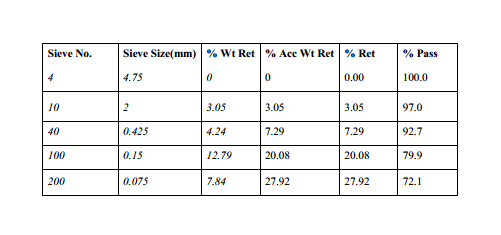
[CE 1.13]
I executed this test to classify the type of soil & differentiate amongst silt & clay. I performed one test for the standard procedure as given in ASTM D4221. I faced an issue during the hydrometer analysis. The hydrometer was giving off the chart readings for the oven dried soil samples. I worked hard and found that the meter was giving odd readings for soil samples having high or slightly low temperature after getting the sample out from the oven. In order to resolve the issue adequately I used oven dried soil samples immediately after passing through sieve#10 which was implied in this test. I did one test for the soil mass & results if the gradation proportion were plotted by me with the grain size distribution curve are displayed below.
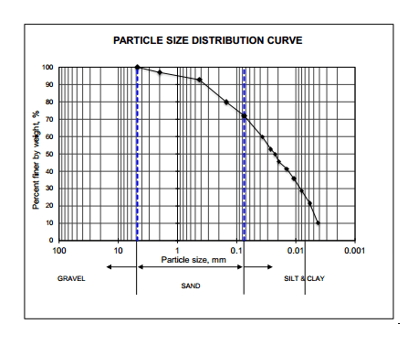
[CE 1.14]
I performed eight specific gravity tests on the soil samples following the ASTM D854-06 standard testing method. This test is basically the ration of the unit weight of soil solids to the unit weight of water at standard condition.
The test results are displayed below -
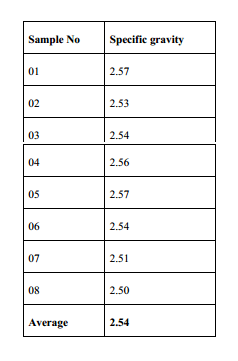
[CE 1.15]
I did Atterberg limits test on the soil samples. This test indicated the consistency & the internal behavior of the soil with the change in the moisture condition. I did this test according to ASTM D4318-06 standard test method. The results showed that the liquid limit of the soil varied according to different samples. Below table & graph show the results of liquid limit test & plot for a liquid limit test respectively.
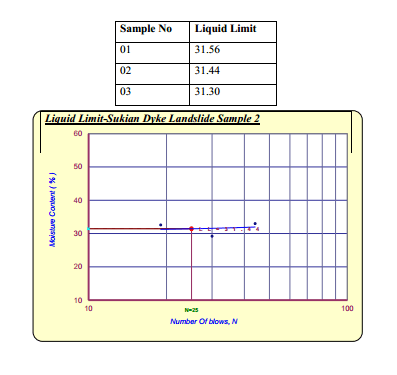
[CE 1.16]
I carried out compaction test implying modified compaction effort & drafted graph between dry density & moisture content as displayed below.
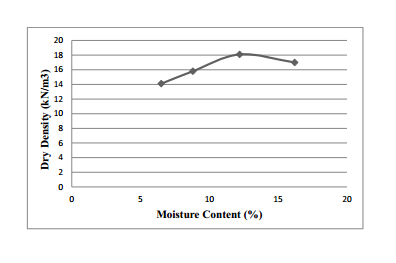
[CE 1.17]
I executed the stability analysis using SLOPE/W software for variable degree if saturation. The materials were pre-defined in the software. First I performed analysis using soil properties obtained for the reconstituted sample as given below Density (Y) = 18 KN/m3 Cohesion (c) = 6.8 KPa Friction Angle (O) = 8.23°.
I worked out shear strength parameters against degrees of saturation as displayed below -
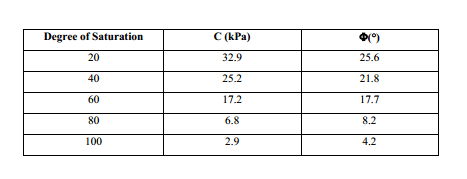
I implied these parameters in the stability analysis of Sukian Dyke Landslide to find out the effect of increase in saturation on the stability using geometry of actual failure surface in the field. The results of the analysis were for SLOPE/W under variation in degree of saturation from 20% to 70%. The analysis showed that for the failure surface exposed in the field, the failure conditions occur before 60% saturation. It can be concluded that Sukian Dyke Landslide occurred when the degree of saturation was close to 60% in the field.
A graph has been plotted between degree of saturation and factor of safety which is shown below:
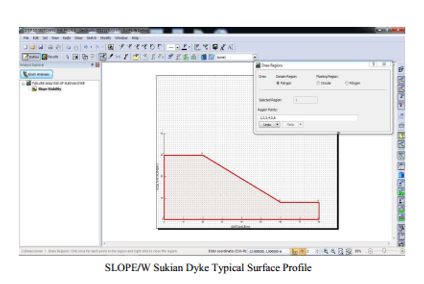
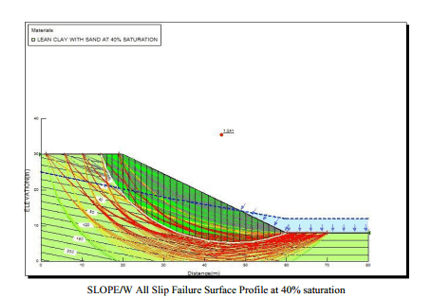
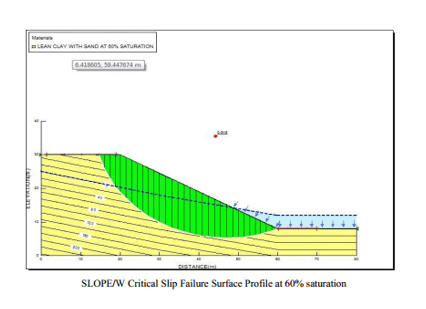
Based on the slope stability analysis of Sukian Dyke landslide; it is evident that the exposed failure surface in the field is not the most critical slip surface. This is because the exposed slip surface in the field is result of progressive failure of the slope. So it can be concluded that the failure was caused by reduction in shear strength due to increase in degree of saturation & development of pore pressure.
[CE 1.18]
I successfully completed this project. The results of our study were in comparison with any other study done before in the same phenomenon. The slope stability analysis indicated critical factor of safety against 58% degree of saturation for both the actual failure surface as well as the most critical slip surface. As the soil mass comprises fine material i.e. CL & A-4(6); the possible reason for failure at such low degree of saturation can be development of excessive pore pressure due to infiltration during severe floods.
This project played a huge impact in enhancing my professional civil engineering skills. It also helped in building leadership qualities as I not only engaged with my team members but also with local authorities present at Mangla site. I also learned about skills like Project scheduling and Completion. It also led to my personality development as I communicated with people belonging to different factions of society. I also figured out problem solving techniques that I encountered while performing different civil engineering tests which are mentioned above. This project proved out to be a complete package in enhancing my technical as well as managerial skills which form an integral part of a civil engineering professional. A challenging project was completed well within the scheduled project completion time.
We hold the apex position in providing services regarding CDR writing for engineers Australia. We are known to have very high success records for consistent team of professional writers having years of experience in the field of CDR preparation. We provide the best and trusted service for CDR writing and reviewing of all kinds of engineering disciplines. We provide services for career episode writing, plagiarism check and removal etc.
Should you need any further information, please do not hesitate to contact us.
Contact: +61-4-8885-8110
WhatsApp: +61-4-8885-8110
(Australia, USA, UK, UAE, Singapore, New Zealand)